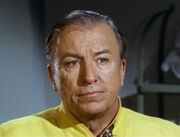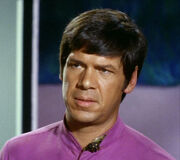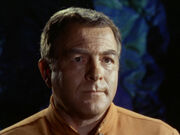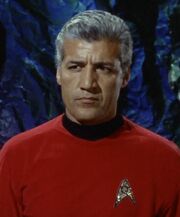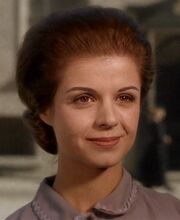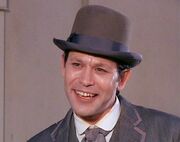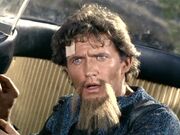By now most of these links are coming from Memory Alpha. The more pictures in the post, the more links to Mem Alpha — that’s the rule of thumb. Anyway, my thanks to them once again for running such a thorough and useful site. As mentioned, it also has a very nice look to it.
Janos Prohaska (b. 1919, Budapest) thought up the Horta. Prohaska died seven years after “Devil,” Wiki says, when he was working on a series for ABC/Wolper and the plane the production had chartered for shooting flew into one of the Sierras.
Prohaska invented the Horta costume and horsed around in the office with it; then Gene Coon wrote a story to match. The result was one of Trek‘s closest approaches to its series ideal, namely we-are-not-the-center-of the-universe combined with different-is-not-bad: the so-called “monster” was protecting her eggs!
What we have here is a classic science fiction situation reinterpreted from a new standpoint, and the standpoint was simply this: more than one perspective is possible.
The choice of situation — monster hunts spacemen — was such a fat, obvious target that hitting it produced an effect that’s now almost as trite as the original cliche. Still, there must have been 18 months or so when the “Devil” reversal seemed like the freshest idea in the world.
And the larger idea — the combo of not-the-center plus difference-not-bad — isn’t trite, even if you disagree with it. It can be rendered into very trite forms, but the idea itself is important and worth expressing. Personally, it’s my favorite, and I don’t claim to be original on that score. Gene Roddenberry said difference-not-bad was an idea that he and his generation of tv writers all tried to advance. Being tv writers of his generation, they probably didn’t do the best job of it, but still — the job was worth doing.
GR was a great believer in difference-not-bad, and I think Gene Coon went a step further and focused on not-the-center, which is a subtler concept and implies difference-not-bad. Coon was an immense liberal and a believer in the need for people to listen to the viewpoints of others. Being tv, “Devil” weighs the odds for the desired outcome; after all, what if the very rocks the miners were there to mine had turned out to be the Horta’s eggs? Try reconciling those interests.
Another dodge: the Vulcan mind meld. This is its first time out (and a huge production for its debut; halfway thru season 2 it would become a good deal more economical and for convenience’s sake might be applied to a simple stone wall). The mind meld is a pure gimme, a straight-up job of tv script soldering: we need to talk with a character that’s so alien it doesn’t have a mouth, what do we do? Well, uh, Spock has this power … A solution that amounts to “Get another alien!”
[ update, Damn it, Anonymous says in Comments that “Dagger of the Mind” did a mind meld before “Devil in the Dark,” and it turns out this is true. I think the news takes some of the snap out of my thoughts on the meld and Spock’s Otherization: yes, Spock is still the weird guy you give wild-card, story-helping powers to, so he’s Other, but it’s not like Gene Coon had to amp up his sense of Spock’s Otherness right when Coon was telling us his parable about how no one is really Other. Reason: reaching for an already invented element takes less gimme hunger than inventing an entirely new bullshit element right on the spot. ]
Each dodge is fraudulent in two different ways, as writing and as thinking. The writing failures are a bit lazy and easy in the way of run-of-the-mill scripting. The failures of thought are a bit lazy and easy in ways that are typically liberal: differences of interest are underestimated, and the liberal’s own understanding of others is greatly overestimated. So, in the course of our lesson about the foolishness of Otherization, Spock gets Otherized into a parking spot for impossible qualities.
On the other hand … great moment for Nimoy, a real chance to wail and he took it. This was when Spock-the-phenom had taken hold, and the show had to keep Nimoy happy.
Shatner was very jealous of the moment, something I surmise from this I Am Spock anecdote. Shatner had to miss the scene’s shooting because of his father’s death. On Monday, back in the studio, he prevailed upon Nimoy to give him a rendition. He kept urging Nimoy to do it bigger, do it all out. When Nimoy was at full pitch (“Pain! Pain!“), Shatner turned to the rest of the cast and crew and said, “Hey, somebody get this guy an aspirin!” Nimoy never forgave him, except that eventually he did because there were movies to be promoted.
A lot of manly men lumbering around in this one, the miners, and they make for a nice lineup of mugs. No women in the cast except the Horta and possibly an ensign or two as extras on the bridge.
Now the mugs …
The sergeant from McCloud, which was the Dennis Weaver series about a cowboy who solves crimes in the big city. The guy, b. 1910, did a ton of work, including appearances in some pretty big films of the late ’50s, early ’60s.
Next, Biff Elliot, b. 1923. Did a lot of war films, was friends with Jack Lemmon. Started out as Mike Hammer in the film of I, the Jury, but apparently his roles got smaller.
Only screen appearance, redshirt div.: John Cavett.
A favorite: Barry Russo, who was also the Commodore in “The Ultimate Computer” (“What in blazes does Kirk think he’s doing?” or words to that effect.) He was a regular on a mid-’60s sitcom with Lee Meriwether. Sometimes he used the screen name John Duke.
Genuinely random redshirt: They think the character’s name was Osborne. Nobody knows the actor’s name, but he pops up in “Devil,” “Archons,” and “Armageddon,” which were all made close to each other. (Like a lot of Star Trek extras, at least the men, he appears to find the work exquisitely painful.)

